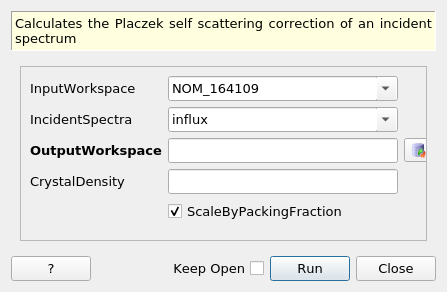\(\renewcommand\AA{\unicode{x212B}}\)
CalculatePlaczekSelfScattering v1¶

CalculatePlaczekSelfScattering dialog.¶
Summary¶
Calculates the Placzek self scattering correction of an incident spectrum
See Also¶
Properties¶
Name |
Direction |
Type |
Default |
Description |
|---|---|---|---|---|
InputWorkspace |
Input |
Mandatory |
Raw diffraction data workspace for associated correction to be calculated for. Workspace must have instrument and sample data. |
|
IncidentSpectra |
Input |
Mandatory |
Workspace of fitted incident spectrum with it’s first derivative. Must be in units of Wavelength. |
|
OutputWorkspace |
Output |
Mandatory |
Workspace with the Self scattering correction, in the same unit as the InputWorkspace. |
|
CrystalDensity |
Input |
number |
Optional |
The crystalographic density of the sample material. |
ScaleByPackingFraction |
Input |
boolean |
True |
Scale the correction value by packing fraction. |
Description¶
This algorithm takes an incident spectrum function and it’s derivative, along with the workspace containing spectrum info and calculates the time-of-flight Placzek scattering correction from the workspaces material sample and detector info. [1] [2] [3] For obtaining the incident spectrum from a measurement (ie beam monitors or calibrant sample), the FitIncidentSpectrum can provide the necessary inputs.
Usage¶
Example: calculate Placzek self scattering correction using a sample detector setup [4]
from mantid.simpleapi import *
import matplotlib.pyplot as plt
import numpy as np
# Create the workspace to hold the already corrected incident spectrum
incident_wksp_name = 'incident_spectrum_wksp'
binning_incident = "0.1,0.02,5.0"
binning_for_calc = "0.2,0.02,4.0"
binning_for_fit = "0.15,0.02,4.5"
incident_wksp = CreateSampleWorkspace(
OutputWorkspace=incident_wksp_name,
NumBanks=10,
XMin=0.1,
XMax=5.0,
BinWidth=0.002,
Xunit='Wavelength')
incident_wksp = ConvertToPointData(InputWorkspace=incident_wksp)
# Spectrum function given in Milder et al. Eq (5)
def incident_spectrum(wavelengths, phi_max, phi_epi, alpha, lambda_1, lambda_2,
lamda_t):
delta_term = 1. / (1. + np.exp((wavelengths - lambda_1) / lambda_2))
term_1 = phi_max * (
lambda_t**4. / wavelengths**5.) * np.exp(-(lambda_t / wavelengths)**2.)
term_2 = phi_epi * delta_term / (wavelengths**(1 + 2 * alpha))
return term_1 + term_2
# Variables for polyethlyene moderator at 300K
phi_max = 6324
phi_epi = 786
alpha = 0.099
lambda_1 = 0.67143
lambda_2 = 0.06075
lambda_t = 1.58
# Add the incident spectrum to the workspace
corrected_spectrum = incident_spectrum(
incident_wksp.readX(0), phi_max, phi_epi, alpha, lambda_1, lambda_2, lambda_t)
incident_wksp.setY(0, corrected_spectrum)
incident_spectrum = FitIncidentSpectrum(
InputWorkspace='incident_wksp',
OutputWorkspace='fit_wksp',
BinningForCalc=binning_for_calc,
BinningForFit=binning_for_fit)
SetSampleMaterial(
InputWorkspace='incident_wksp',
ChemicalFormula='Co')
CalculatePlaczekSelfScattering(
InputWorkspace='incident_wksp',
IncidentSpecta='fit_wksp',
OutputWorkspace='placzek_scattering',
Version=1)
References¶
Categories: AlgorithmIndex | CorrectionFunctions
Source¶
C++ header: CalculatePlaczekSelfScattering.h
C++ source: CalculatePlaczekSelfScattering.cpp
